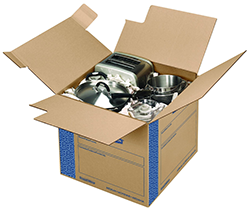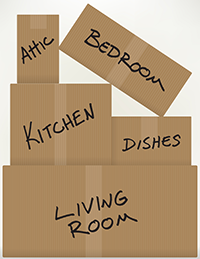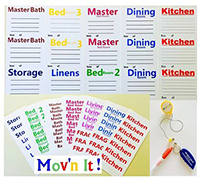Lee's Moving Tips
General Packing
1. Pack A Suitcase - For each member of the family moving, pack a suitcase as if you're all going on a 3-day vacation, including changes of clothes, medications, eyeglasses, toiletries, etc. Keep the suitcases separated from all the other items to be moved, such as in your car, at your new workplace, etc. so you'll have everything you need for the first few days without searching through boxes.
2. Create "Open Me First" Boxes - Pick one or two boxes per room as "Open Me First" boxes. Put in them the things you'll need first at your new location. Then mark the sides of the boxes so you'll know which ones are which.
3. One Room At A Time - Wherever possible, work on packing just one room at a time (instead of several all at once) to keep things focused and organized.
4. Less Is More - Use packing as a way to clean out belongings for donations, a yard sale, and/or the recycling center. Aim to eliminate 1/3 of your belongings. You'll save time and expense.
5. Off The Floor - Instead of the floor, use a completely cleared-off table top or counter in each room for packing boxes. You'll find you get much more accomplished.
6. Tracking Small Parts - When taking apart items to be moved, such as tables, securely tape screws and other small parts securely to the underside of the item. You'll always know where to look and save time putting things back together.

7. Save Space - Use towels, pillows, and old clothing that you seldom wear as extra padding around fragile items. It will save room in your boxes and leave room in your suit case for everyday clothes.
8. Criss-cross Tape - Tape boxes along the seams where the flaps meet together. Then tape perpendicularly at the center of the first tape, forming a cross.
9. Stacking - Stack the largest and heaviest boxes on the bottom, and make sure nothing inside can be crushed, causing a collapse. Then place smaller lighter boxes on top creating a pyramid shape to prevent the column from tipping over.
10. The 30-Pound Rule - Keep each box below an absolute maximum weight of 50 pounds and wherever possible below 30 pounds. Heavier boxes lead to injuries, are much more likely to burst their tape or seams and tend to get dropped.
11. Scales - Pack heavy items like books and dinnerware in small boxes and large and light weight items in larger boxes. Keep a bathroom scale in the room you're packing so you can keep the boxes below the weight limits.
Packing Electronics
12. A Picture Is Worth A 1000 Words - Wiring for computers, speakers, TV’s, etc., can be complicated. Use a digital or cell phone camera to take pictures of how they are hooked up. Use the flash, or make sure there is plenty of light, then carefully focus the picture for clarity. Print each picture and place it in the top of the box holding the items. This will make hooking up the items in your new place much easier.
13. Original Is Best - Always use the original packaging whenever possible. For example, you will not find a safer way to ship your new flat screen TV than the box it was shipped in from the factory. Some manufacturers require their products to be returned in the original package for warranty repairs or it voids the warranty. Most of us throw away the original box or packaging as soon as we empty it, but keeping it until the warranty has expired is best. It is also a good idea to keep it in case you need to move again.
14. Double Boxing - Always try to put your electronics and other fragile devices back into the original manufacturers packaging. Whenever that is not possible pack them first in a box with an excessive amount of biodegradable packing peanuts or bubble wrap. Then pack that box in a larger box filled with more of the same type of packing materials. This two-box system may seem like a pain but it will do a much better job of isolating items from jarring or impacts.
15. No Loose Ends - When storing wires, cables, cords, and similar items, carefully wrap each one with cable organizers, heavy twist ties, drawtite straps, thick string, heavy rubber bands, or strong tape. Implement a labeling system to ensure you can identify which cable belongs to each device. To prevent tangles and potential damage, never toss unwrapped cords into boxes.
16. Cord Labels - Consider getting a label maker and labeling the ends of each cord and where it is connected on all devices. Then you'll know exactly which cord you're seeing and where each end connects when you put things back together.
17. The Two-inch Rule - Use at least 2" of biodegradable packing peanuts around each side of fragile items.

Box Inventory and Labels
18. “Fat” Is In - Use the thickest, darkest marker you can find for labeling boxes. Pencils, pens, or light markers are almost impossible to see from just a few feet away.
19. Two Sides - Label each box on the two broadest sides, opposite one another. That way if a box gets turned, you can still identify its contents.
20. Abbreviate Room Names - Start box labels with the abbreviated name of the room followed by a box number, such as “BTH2-6” for "second bathroom, 6th box." You can then track each box to make sure everything arrived safely.
21. Label "Open Me First" - on boxes where it applies. Prioritize the content of each box and pack the boxes with the highest priority last. That way you can get to the most important boxes first when you begin to unpack. Things like work clothes, sundries, kitchen items, etc., would be part of that list.

22. Mark "Fragile" - Where appropriate. Marking boxes with Fragile or Glass lets you know that those boxes should be handled with care. When packing make sure each item is wrapped in a material that will protect them from movement during travel. This also lets your movers know not to stack heavier items on top of these boxes.
23. Identify Contents - Identify the major contents and where they came from, such as "Medicine Cabinet" or "Linen Closet - Towels and Wash Cloths."
24. Box Inventory - Keep a clipboard and write down each box's room, box number and contents (graph paper is great for keeping things recorded neatly).
25. Verifying Delivery - When unloading, check off each box as it gets unloaded at your new place. Then you'll know everything arrived safely with no missing or damaged items. A good mover will give you time to check each box as they take it off their truck. Most movers offer packing and unpacking service but you should verify that everything made it to its new home.

26. Labels Out - Ask movers to stack boxes in your new place with the labels facing out so that you can easily spot a specific box.
